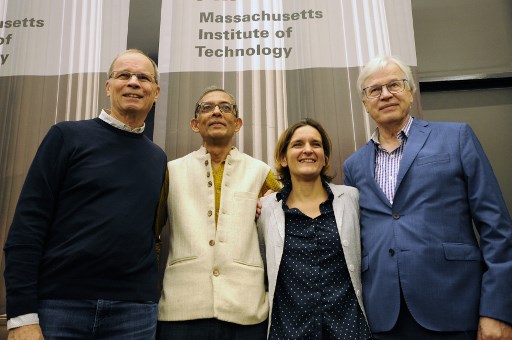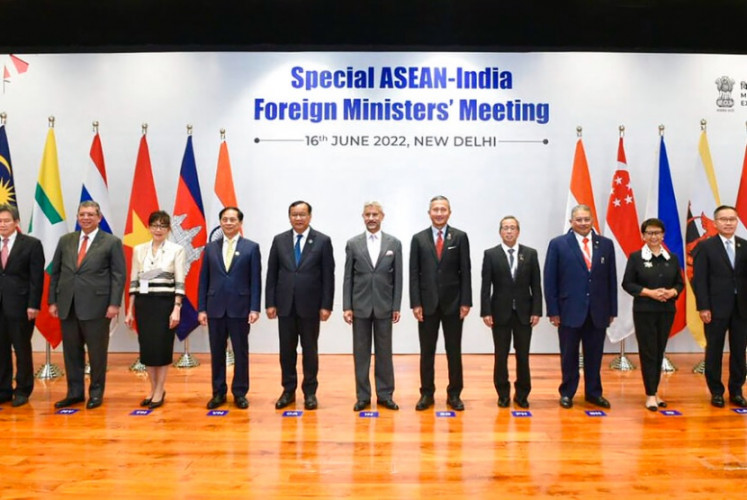Nobel Prize: SD Inpres, poverty research in Indonesia and women in economics
The echoes of the Nobel Prize winners especially resonated strongly in Indonesia as locals were proud to learn that Esther Duflo, a 46-year-old mother of two, contributed to research on poverty in Indonesia, apart from other countries from Morocco to India. Duflo also studied the effects of massive primary school development in Indonesia under the Soeharto presidency between 1973 and 1978, famously known as “SD Inpres”, on education and wages.
Change Size
 Nobel Prize winners in economics, Abhijit Banerjee (R) and Esther Duflo, speak during a press conference at MIT in Cambridge, Massachusetts on October 14, 2019. (AFP/Joseph Prezioso)
Nobel Prize winners in economics, Abhijit Banerjee (R) and Esther Duflo, speak during a press conference at MIT in Cambridge, Massachusetts on October 14, 2019. (AFP/Joseph Prezioso)
T
he name Esther Duflo rose to fame all of a sudden this week as the youngest woman and the second to be a recipient of the esteemed Nobel Prize in economics. The French-American economist received the prize along with MIT professor Abjhijit Banerjee – her husband – and Harvard development economist Michael Kremer “for their experimental approach to alleviating global poverty”.
The world applauds the trio’s prize after decades of the Nobel Prize in economics being dominated by contributions in macroeconomics, markets and economic theories, among others. The latest award is timely since the trade war-driven global economic slowdown has resulted in job losses and more people inching closer to and crossing the poverty line around the world.
But the echoes of the Nobel Prize winners especially resonated strongly in Indonesia as locals were proud to learn that Duflo, a 46-year-old mother of two, contributed to research on poverty in Indonesia, apart from other countries from Morocco to India. Duflo also studied the effects of massive primary school development in Indonesia under the Soeharto presidency between 1973 and 1978, famously known as “SD Inpres”, on education and wages.
Published in The American Economic Review in 2011, the research found that the top-down construction of primary schools led to an increase in education and earnings. Indonesian children aged 2 to 6 in 1974 received 0.12 to 0.19 more years of education for each school constructed per 1,000 children in their region of birth, Duflo found. Estimated returns were in general larger in developing countries than industrialized countries.
Five presidents and three generations later, times have changed, but the quest for better education and wages for Indonesians – which President Joko “Jokowi” Widodo would call human capital and skills – through school constructions and the quantity approach remain relevant.
Vocational education is at the forefront of this approach in Jokowi’s time, as opposed to primary schools in Soeharto’s time. Jokowi has targeted revitalizing 5,000 vocational schools (SMK) by 2024 – out of the country’s 14,000 SMKs – so they can upgrade their teachers, curriculums and facilities to make the graduates more able to meet employers’ needs.
This is against the backdrop of SMK graduates having the highest unemployment rate in Indonesia compared with other education levels, including primary schools, although SMKs, a high school-level education, are meant for graduates going straight to work without expensive university studies.
The ultimate goal of all of this effort is to maintain Indonesians’ skills competitiveness in the era of the Fourth Industrial Revolution in which machines and robots can do human work. That way Indonesians’ income could progress and they will be protected from poverty.
However, as according to Duflo and Banerjee’s 2011 book Poor Economics, the poverty trap is difficult to avoid, unless we talk to the poor to find the root of their problems. In 2008 they visited slums in different parts of Indonesia to speak with the breadwinners of local families, who said all the things we already know: how the spiraling issues of nutrition, health, education, extortion by public officers and bad public management make it difficult to lift people out of poverty.
You can feel the researchers sympathize over the living conditions of the poor, but also, as Duflo put it, trust that economics can do something to make their lives better.
Duflo and Banerjee’s tale of agriculture worker Solihin from a village in Bandung – which she considered a “prosperous” area in Java – who explained the poverty trap for his family of 13 children meant facing price increases that would affect their nutritional intake and lower educational performance, also remains relevant to many.
Poor healthcare access and lending traps for Ibu Emptat, scrap collector Sudarno and his family in Cicadas who expect their children to support them in their old age and Ibu Tine’s small garment business dispute that caused her family to lose their primary source of income – are still making Indonesians fall into poverty.
Many households in Indonesia struggle to spend above Rp 1.99 million (US$140) per family per month as of March this year. As many as 9.41 percent of Indonesians must live on less than Rp 42,250 per capita per month. A decade ago, 14.15 percent of the population was in poverty.
Inequality is obvious with the poverty rate in Maluku and Papua double that of other islands at 20.9 percent. The difference is staggering with Kalimantan and Java recording 5.93 percent and 8.44 percent, respectively. The socio-economic aspects of the different parts of Indonesia present a challenge to have one single policy and funding solution for poverty alleviation.
The Poor Economics approach of actually listening to the voices of the poor has won the hearts of many. The book doesn’t believe in a one-size-fits-all formulaic generalization for addressing poverty issues. Instead, it encourages on-the-ground research for an empirical approach to aid and development road maps.
The winning trio of the Nobel Prize in economics sparks fresh hope for the increasing popularity of development economics and experimental research in poverty, so as to create actionable policy suggestions that can lift many people out of poverty, sustainably.
Hope is high that our own Indonesian economists could contribute more on poverty alleviation in their own country by going to remote areas and villages and talking those who barely make ends meet to complement dataset-based research.
Duflo’s victory especially provides crucial inspiration for more women to have a role in economics. Various studies in the United States show that women are far less represented in economic majors than in other majors. Even when women enter economics, they are more likely to be discriminated against on the basis of sex.
So here’s to women in economics! And to more on-the-ground research on poverty.









